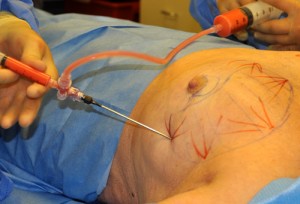Fat grafting is an emerging and versatile technique in plastic surgery. While it can be used just about anywhere on the body, one of the trendiest areas for fat injections is the breast. Whether it is for reconstruction of breast defects or cosmetic enlargement, fat has become an accepted method of soft tissue volume enhancement for selected breast problems.

Once liposuction appeared in the U.S. in 1981, the idea of using the lipoaspirate as a soft tissue filler was a logical extension for the liquified material. But it was quickly learned that the liquified lipoaspirate did not last or result in much volume retention. This concept was subsequently refined with the technical advancement of concentrating the lipoaspirate (removing the non-cellular material) and using a microinjection placement technique in order to improve survival.
Studies have shown that fat is composed of a variety of different cells, including adipocytes, preadipocytes, endothelial cells, smooth muscle cells, fibroblasts, and adipose-derived stem cells. The value of the injected fat graft lies in the mature adipocytes and the adipose-derived stem cells. (ADSCs) Injectate volume survival is based on unknown ratios of mature fat cells staying intact and ADSC conversion. Since fat is not just a source of stem cells but quite a magnanimous source of them, their transfer into a recipient site like the breast poses some intriguing questions.
As fat is now being injected into breasts on a wide-scale basis, questions arise in regards to both its efficacy and safety. In regards to safety the important issues are.. does it interfere with breast cancer detection (mammography and breast ultrasound), could it potentially even cause breast cancer and what are occurrence of complications? (infection, development of cysts, fat necrosis)
The primary concern with fat grafting of the breast is the potential of the stem cell and growth factors that are contained in the graft of stimulating breast cancer. In vitro laboratory studies have shown that adipose derived stem cells can stimulate growth in cancer cells. However, this has not been shown to be the case in actual clinical use. In an article titled “Long term Outcomes Following Fat Grafting in Prosthetic Breast Reconstruction: A Comparative Outcome” published in the November 2012 issue of the Plastic and Reconstructive Surgery journal, the authors looked at breast cancer reconstruction patients who were reconstructed with implants. These patients then secondarily had fat grafting to their reconstructed breasts. The question the authors looked at was did this cause breast cancer recurrence. The answer was that it did not cause local tumor recurrence and did not affect survival on long term follow up.
Another concern regarding fat grafting to the breast was the potential for interference with breast mammography and ultrasound. Fat grafting can cause areas of fat necrosis, calcification, and oil cysts which theoretically could interfere with the detection of breast cancer. In the May 2012 issue of Plastic and Reconstructive Surgery journal, the authors performed a blinded study looking at mammographic changes after fat transfer compared to changes after breast reduction. They found that compared to breast reduction, fat grafting to the breast produced less radiographic changes. In another paper published in the October 2012 issue, the authors looked at finding a reliable modality to distinguish areas of palpable fat necrosis from malignancy. They found that ultrasound was a safe and reliable method to differentiate fat necrosis from malignant lesions.
Known risks and complications associated with fat grafting to the breast include infection, variable resorption of the engrafted fat resulting in asymmetry and areas of palpable fat necrosis or oil cysts. Despite the excitement over fat grafting to the breast amongst plastic surgeons, patient satisfaction with this procedure is mixed particularly in the cosmetic breast patient. This is undoubtably because the survival of fat grafting is exceedingly technique dependent and is often a multistep process. That being the case, patients who are considering fat grafting for breast augmentation must have realistic (and modest) goals and understand that they may require several operations in order to achieve that goal.
Dr. Barry Eppley
Indianapolis, Indiana


